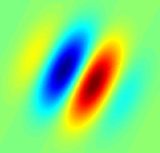
Simple cell
Encyclopedia

Visual cortex
The visual cortex of the brain is the part of the cerebral cortex responsible for processing visual information. It is located in the occipital lobe, in the back of the brain....
is a cell that responds primarily to oriented edges and gratings (bars of particular orientations). These cells were discovered by Torsten Wiesel
Torsten Wiesel
Torsten Nils Wiesel was a Swedish co-recipient with David H. Hubel of the 1981 Nobel Prize in Physiology or Medicine, for their discoveries concerning information processing in the visual system; the prize was shared with Roger W...
and David Hubel in the late 1950s .
Hubel and Wiesel named these cells "simple," as opposed to "complex cell
Complex cell
Complex cells can be found in the primary visual cortex , the secondary visual cortex , and Brodmann area 19 .Like a simple cell, a complex cell will respond primarily to oriented edges and gratings, however it has a degree of spatial invariance. This means that its receptive field cannot be...
", because they shared the following properties :
- They have distinct excitatory and inhibitory regions.
- These regions follow the summation property.
- These regions have mutual antagonism - excitatory and inhibitory regions balance themselves out in diffuse lighting.
- It is possible to predict responses of moving stimuli given the map of excitatory and inhibitory regions.
Some other researchers such as Peter Bishop and Peter Schiller used different definitions for simple and complex cells .
Such cells are tuned to different frequencies and orientations, even with different phase relationships, possibly for extracting disparity (depth) information and to attribute depth to detected lines and edges. This may result in a 3D 'wire-frame' representation as used in computer graphics. The fact that input from the left and right eyes is very close in the so-called cortical hypercolumns is an indication that depth processing occurs at a very early stage, aiding recognition of 3D objects.
Using the mathematical Gabor model with sine and cosine components (phases), so-called complex cell
Complex cell
Complex cells can be found in the primary visual cortex , the secondary visual cortex , and Brodmann area 19 .Like a simple cell, a complex cell will respond primarily to oriented edges and gratings, however it has a degree of spatial invariance. This means that its receptive field cannot be...
s are then modeled by computing the modulus of complex Gabor responses (cos + i*sin). Both simple and complex cells are seen as linear operators (filters) because they respond to many patterns.
Later, many other cells with specific functions have been discovered: (a) end-stopped cells which are thought to detect singularities like line and edge crossings, vertices and line endings; (b) bar and grating cells. The latter are not linear operators because a bar cell does not respond when seeing a bar which is part of a periodic grating, and a grating cell does not respond when seeing an isolated bar.

